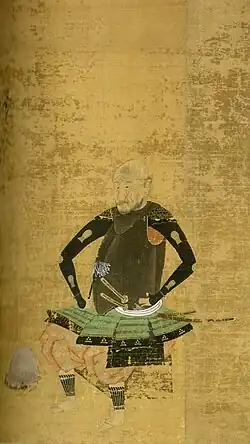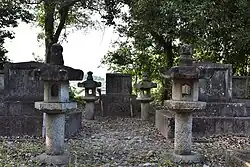Watanabe Moritsuna
Watanabe Moritsuna | |
|---|---|
| 渡辺 守綱 | |
 Watanabe Moritsuna | |
| Lord of Terabe Castle | |
| In office 1590–1620 | |
| Personal details | |
| Born | 1542 Mikawa Province |
| Died | 1620 Mikawa Province |
| Nickname | Yari no Hanzō (Hanzō the spear) |
| Military service | |
| Allegiance | |
| Commands | Terabe Castle |
| Battles/wars | Battle of Nagasawa (1561) Battle of Azukizaka (1564) Siege of Kakegawa (1569) Battle of Anegawa (1570) Battle of Mikatagahara (1573) Battle of Nagashino (1575) Battle of Komaki-Nagakute (1584) Siege of Odawara (1590) Battle of Sekigahara (1610) Siege of Osaka (1614) |
Watanabe Moritsuna (渡辺 守綱) (1542–1620) or Watanabe Hanzō, nicknamed Yari no Hanzō (槍の半蔵, Spear Hanzō), was a Japanese samurai of the Watanabe clan, who served the Tokugawa clan under Tokugawa Ieyasu and later served as a hatamoto and then a daimyo to the Tokugawa shogunate. He is one of the Tokugawa 16 divine generals (Tokugawa jūrokushinshōjin).[1][2][3]
Biography
Watanabe Moritsuna was born in Urabe Village in Nukata District, Mikawa Province (present day Okazaki) in 1542. His father was Watanabe Takatsuna, a retainer for the Matsudaira clan. His maternal grandfather was Watanabe Yoshituna, who fought under Sakai Tadatsugu against the Oda clan.
Watanabe joined the Tokugawa in 1557, and served Matsudaira Motoyasu (later named Tokugawa Ieyasu) in major military campaigns for most of his career. In 1561, Moritsuna achieved military merit during the battle of Nagasawa castle, as he managed to personally slay the enemy general during the battle. After this battle, he participated with the Tokugawa clan pacification of the rest of Mikawa province.[4]
In 1563, Watanabe Moritsuna joined the Ikkō-ikki rebels in Mikawa along with his father Takatsuna, and for a time became an enemy of Tokugawa Ieyasu. After the uprising was subdued in 1564 by Ieyasu at the Battle of Azukizaka, where Moritsuna was wounded by Abe Tadamasa and Takatsuna was killed, Moritsuna was pardoned and returned to serve the Tokugawa clan.[5][6]
In 1569, during the Siege of Kakegawa Castle in Tōtōmi Province, Watanabe, together with Honda Shigetsugu and other Tokugawa samurai, fought in close combat until they managed to breach the castle gate.[7] In 1570, Moritsuna fought in the Battle of Anegawa against the Azai and the Asakura clans.
In 1573, during the Battle of Mikatagahara, Moritsuna and Hattori Hanzō performed with exceptional skill with their spears (in Japanese, yari (槍)). During the battle he fought in retreat to cover Ieyasu and personally blocked any incoming enemy attacks with his spear.[8] Following the retreat, Moritsuna, along with Torii Mototada, led the flanking maneuver of the Tokugawa counter attack. Following the battle, Moritsuna was nicknamed Yari no Hanzō (Spear Hanzo) and praised in poetry, alongside Hattori Hanzō as Oni no Hanzō (Hanzō the demon) and Atsumi Gengo as Kubi-Tori Gengo (Gengo the headtaker).[9][10][11] [12][13][14][15]
In 1575, Watanabe fought in the Battle of Nagashino, where he killed both Yamamoto Sugasuke, the eldest son of Yamamoto Kansuke, and the ronin Nawa Murisuke, a commander under Takeda Nobuzane. At the same battle, Watanabe's younger brother, Watanabe Masatsuna, killed Sanada Nobutsuna.
In 1579, Matsudaira Nobuyasu was accused of treason and conspiracy by Oda Nobunaga and was therefore ordered to commit seppuku by Ieyasu. Watanabe was to assist in the seppuku ritual and behead Nobuyasu but wavered at the last second.[a]
In 1582, Watanabe was one of Ieyasu's escorts during his escape to Mikawa in the aftermath of the assassination of Oda Nobunaga.
In 1584, Watanabe fought in the Battle of Komaki and Nagakute.[16][b]
After the Siege of Odawara (1590), Watanabe was given control of a domain in Musashi of 3,000 koku and command of 50 ashigaru infantry.[17]
In 1608, Watanabe became a retainer for the ninth son of Ieyasu, Tokugawa Yoshinao of the Owari Domain. His domains were increased with lands in Owari Iwasaku of 5,000 koku and in Mikawa of 5,000 koku, making him a daimyo with a total of 14,000 koku.[18] In 1610, Watanabe served in Ieyasu's guards during the Battle of Sekigahara. Watanabe served in both the Winter Siege (1614) and the Summer Siege (1615) of Osaka, as guardian to Yoshinao. In 1618, Watanabe was appointed Lord of Terabe Castle.[19]
Watanabe wore European-style armor, including a morion helmet and nanban dou (dō) gusoku.[20]
Watanabe wrote his memoirs in Watanabe Chūemon.[6]
Watanabe died in 1620. Watanabe Moritsuna's grave is located in Shukoji Temple in Toyota, Aichi, founded in his honor by his grandson, Watanabe Harutsuna.[21] A second Shukoji temple in his honor is located in Nagoya.
Family
Watanabe's wife was the daughter of Hiraiwa Chikayoshi. He had three sons and four daughters. The eldest son, Watanabe Shigetsuna (1574-1648), fought for Ieyasu at the Battle of Sekigahara and would be the first of the Hanzo branch of the Watanabe clan. Watanabe's grandson and Shigetsuna's fifth son, Watanabe Yoshitsune (1611-1668), would be the first of the Hakata Watanabe.
Appendix
Footnotes
- ^ The source of Watanabe's involvement in Nobuyasu's seppuku is the Kashiwazaki Monogatari (柏崎物語; 1787), cited in the Tokugawa Jikki (1849). The Kashiwazaki Monogatari is notable for associating Tokugawa superstition of Muramasa swords to Nobuyasu's seppuku. Later editions of the Tokugawa Jikki replace Watanabe with Hattori Hanzō.
- ^ Chinoike Park, literally "Blood Pond Park", in Nagakute is named for the pond where Watanabe and his soldiers washed their weapons following the battle.
References
- ^ Harada Kazutoshi (2009, p. 300)
- ^ 奥出 賢治 (2002). 徳川十六将図再考 [Reconsideration of the Sixteen Tokugawa Generals] (in Japanese). Nagoya City Museum Research Bulletin. pp. 1–21. Retrieved 6 May 2024.
- ^ Kanō Ryūsetsu (1556-1618). "Sixteen Tokugawa Generals Tokugawa Jurokushozu" [Sixteen Tokugawa Generals Tokugawa Jurokushozu]. bunka.nii.ac.jp (in Japanese). Tsuruoka City, Yamagata Prefecture Chido Museum: NII Powered by GETA (C) The Agency for Cultural Affairs. Retrieved 20 May 2024.
{{cite web}}: CS1 maint: numeric names: authors list (link) - ^ Watanabe Moritsuna (2023). "【深掘り「どうする家康」】渡辺守綱は「徳川十六神将」の一人で、一向宗の信者だった" [[Digging deeper into "What will Ieyasu do?"] Watanabe Moritsuna was one of the "Tokugawa 16 Divine Generals" and a follower of the Ikko sect]. yahoo.co.jp/expert/articles/ (in Japanese). 渡邊大門 無断転載を禁じます。 © LY Corporation. Retrieved 3 June 2024.
- ^ Masatoshi Itō (伊藤正敏) (2008). 寺社勢力の中世: 無縁・有縁・移民 (in Japanese). 筑摩書房. p. 197. ISBN 978-4480064356. Retrieved 26 May 2024.
- ^ a b Carol Richmond Tsang (2007). "From Peak to Defeat, 1554–1580". War and Faith. Harvard University Asia Center. pp. 200–234. doi:10.1163/9781684174577_008. ISBN 9781684174577. Retrieved 27 May 2024.
- ^ Kawasaki Fumitaka (1985). 徳川家康・伊賀越えの危難. 鳥影社. p. 115. ISBN 4795251126. Retrieved 26 May 2024.
- ^ Tadachika Kuwata (桑田忠親) (1968). 日本武将列伝: 東西決戦編 [Biography of Japanese military commanders: Decisive battle between East and West]. 新編・日本武将列伝. p. 282. ISBN 978-4-253-00366-7. Retrieved 26 May 2024.
- ^ Kaneyoshi Takayanagi (高柳金芳) (1980). 図說江戶の下級武士 (in Japanese). 柏書房. p. 124. Retrieved 26 May 2024.
- ^ 三重県 (Japan). 警察本部. 警務部 (1964). 三重県警察史, Volume 1. 三重県警察本部警務部警務課. p. 201. Retrieved 26 May 2024.
- ^ Atsushi Kawai (河合敦) (2022). 徳川家康と9つの危機 (in Japanese). PHP研究所. Retrieved 26 May 2024.
- ^ Arthur Lindsay Sadler; Stephen Turnbull (2009). Shogun: The Life of Tokugawa Ieyasu. Tuttle Publishing. p. 102. ISBN 978-1462916542. Retrieved 26 May 2024.
- ^ Roald Knutsen; Patricia Knutsen (2004). Japanese Spears: Polearms and Their Use in Old Japan. Global Oriental. p. 54. ISBN 1901903567. Retrieved 26 May 2024.
- ^ "Samurai War Stories Page 14". Retrieved 26 May 2024.
Atsumi Gengo – Article 47
- ^ George Caiger · (1939). Tell Me about Tokyo. Hokuseido Press. p. 32. Retrieved 26 May 2024.
- ^ 豊橋市 (1973). 豊橋市史, Volume 1 豊橋市史, 豊橋市史編集委員会 (in Japanese). 豊橋市. p. 457.
- ^ 吉川弘文館 (1962). 肖像選集, Volume 1 肖像選集, 日本歴史学会 (in Japanese). 日本歴史学会. p. 162. Retrieved 27 May 2024.
- ^ 清田黙 (1972). 德川加除封錄 (in Japanese). 近藤出版社. p. 217. Retrieved 27 May 2024.
- ^ "Jcastle - Terabe Castle".
- ^ Tsunoda Akio (2023). "南蛮渡来の西洋式甲冑!上杉討伐に際し渡辺守綱が家康から賜った甲冑がコチラ【どうする家康】". mag.japaaan.com (in Japanese). Japaaan Magazine. Retrieved 17 June 2024.
※Addendum to the Toshogu Shrine Chronicles, Volume 9, "Armor Imported from the South."
- ^ ""Machikuru - Shukoji Temple"".
Bibliography
- Harada Kazutoshi (2009). Art of the Samurai Japanese Arms and Armor, 1156-1868. Metropolitan Museum of Art (New York, N.Y.). ISBN 9781588393456. Retrieved 6 May 2024.
